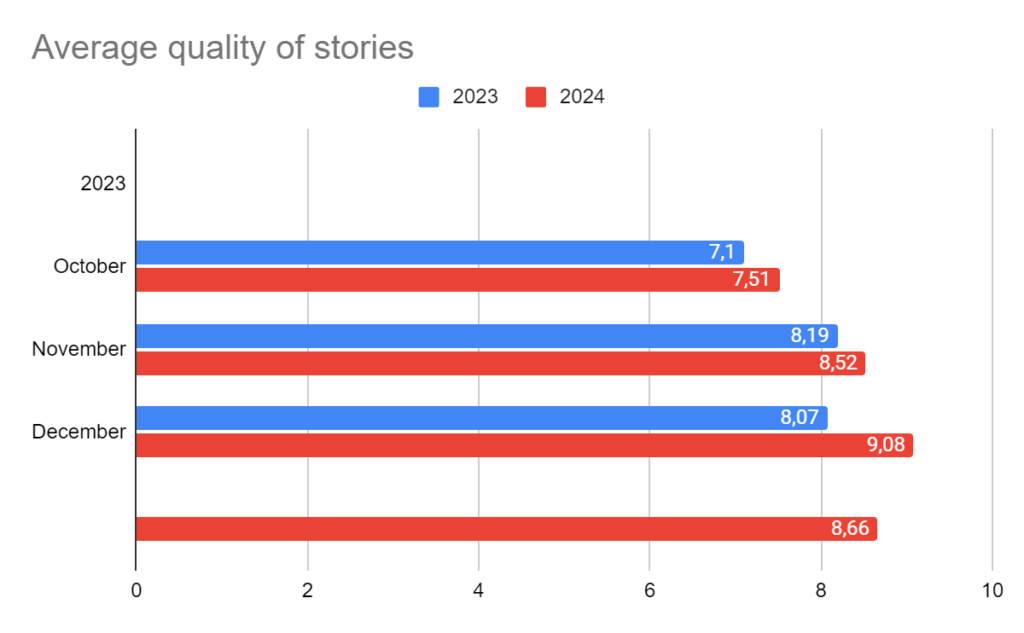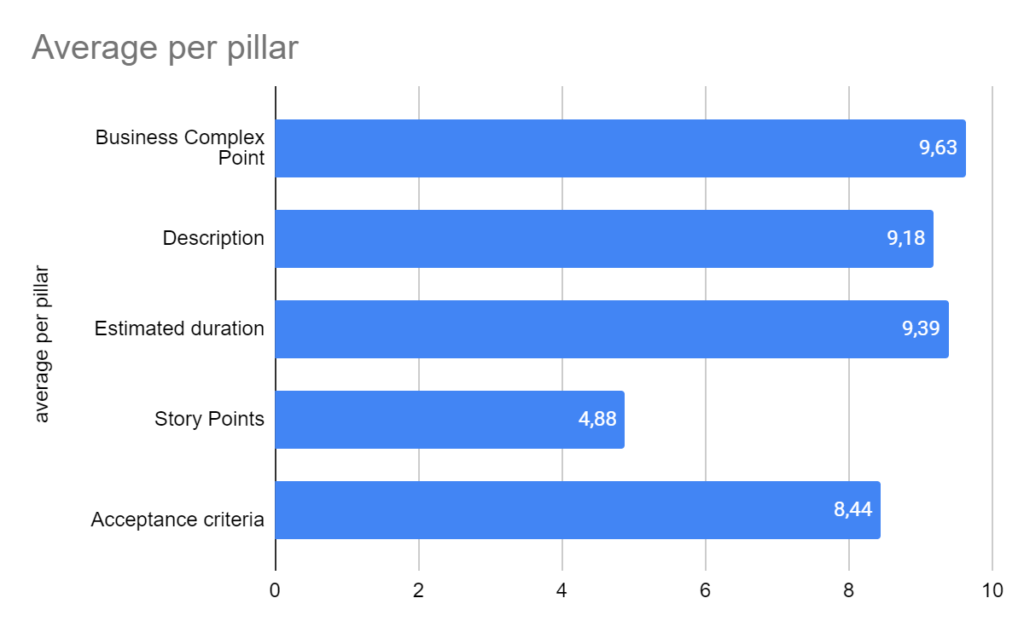We often talk about StackSpot’s impact on the software development cycle, speeding up coding and critical stages such as quality assessment and security. But did you realize that StackSpot can also enhance digital product management? This article introduces a product management use case unveiling StackSpot AI’s role in intelligent backlog refinement.
The results were impressive. The average refinement time for each user story dropped from 9 days to just 2 days, marking a 72% reduction. Moreover, the team’s average number of stories delivered per month climbed from 20 to 27, reflecting a 35% increase.
StackSpot AI has become a valuable ally in product management — particularly during backlog refinement — improving story quality and supporting the construction of a consistent backlog, which is key to successful product development (Sutherland, J. 2014). Want to know how? Keep reading.
Artificial intelligence and product management
The use of artificial intelligence in product management is becoming increasingly prevalent. AI provides powerful tools to optimize processes, improve the quality of deliveries, and support strategic-decision-making (SMITH, 2021).
According to the Agile Alliance and Scrum Guide, 2023, backlog refinement is an essential step in product management to improve delivery quality.
Backlog refinement is an ongoing process where the development team and Product Manager review and detail the items in the product backlog to ensure that they are ready to be worked on. During refinement, backlog items are analyzed, prioritized, detailed, and estimated.
These are key aspects of backlog refinement:
- Prioritization: Backlog items are ranked based on their value to the business, urgency, and dependencies.
- Detailing: Items are detailed with enough information for the development team to understand and implement them. This step can include descriptions, acceptance criteria, mockups, etc.
- Estimate: The development team estimates the effort required to complete each item in the backlog.
- Breakdown: Large or complex items are broken down into smaller, more manageable items.
- Discussion: The team discusses the backlog items to clarify doubts and get expectations in line.
Using artificial intelligence at this stage can make backlog refinement more efficient, enhancing quality and agility. And this is where StackSpot AI becomes an excellent product management ally.
Improving story quality with StackSpot AI
StackSpot AI is an innovative product that optimizes software development through automation and artificial intelligence. It aims to empower developers, IT teams, and organizations to improve efficiency and code quality and accelerate the delivery of software projects.
But the impact of StackSpot AI goes even further! The tool transforms how Product Managers (PMs) write features and user stories, making them more transparent, concise, and aligned with the product’s goals.
The quality of user stories is crucial to the product’s success, development speed, and delivery quality. When the quality of the feature and user story is compromised, the team’s understanding of the stories is affected, leading to longer execution times, rework, defects, and, ultimately, delivery delays (Sutherland, 2014).
Using natural language processing (NLP) techniques, StackSpot AI can suggest slicing value deliveries based on specific methodologies and according to each product’s context and needs. For example, the INVEST technique, created by William C. Wake and outlined in the book Extreme Programming Explored, points out important story characteristics.
StackSpot AI also improves the writing of features and stories, ensuring they are understandable to the whole team, regardless of their technical or business background. Additionally, the tool helps identify gaps or ambiguities in descriptions, suggesting adjustments to ensure that expectations are clearly defined.
Quick Commands: How to use this StackSpot AI capability to improve feature and user story creation
StackSpot AI introduces an innovative approach to enhancing the quality of features and user stories in software development. The platform integrates Quick Commands or predefined instructions that can be sent to large language models (LLM) to perform specific actions. These commands provide quick and efficient ways to contextualize the LLM. They are straightforward and easily accessed with a right-click.
This combination encourages the adoption of agile practices and improves software quality, ensuring that features and stories are in line with project objectives and effectively implemented.
Here are some examples of how to use Quick Commands to create features and user stories:
1. Use Quick Commands with user story templates
StackSpot AI offers Quick Commands with templates for creating user stories, ensuring format consistency and making it easier for the development team to understand and implement them. When creating a template, the Product Manager can choose it according to the methodology that best suits their context.
Below is an example using the INVEST Bill Wake, 2003 methodology and Product Backlog Building (PBB) by Pichler, Roman, 2010.
# Example of Quick Command for Story
You are the Product Manager, and you have to slice development stories for software engineers. The input for you to create will be the description of a FEATURE:
Stories must meet the following criteria:
Independent: be a user story independent of others, i.e., that does not depend on other actions to happen. Be an isolated action, if possible.
Negotiable: Being negotiable is linked to the essence of the story because the essence is what is important to the user story, and the details are negotiable.
Valuable: it needs to add value. Therefore, to be considered a good story, it needs to add value to the end product, especially the customer. Otherwise, there is no point in its existence.
Estimable: it must be estimable in various senses, such as time, added value, and labor costs.
Small: It must fit into a two-week sprint, and being small is important to achieve this. In addition, its size also influences the objective of being simple and straightforward.
Testable: adicieature.
All must contain a description of at least 100 characters and no more than 300.
[[select_Code}}
2. Define clear acceptance criteria
Use Quick Commands to define clear and measurable acceptance criteria for each story, such as Behavior-Driven Development (BDD) tools by Smart and John (2014) that allow you to describe the expected behavior of the software in accessible language.
#{story-description.answer}}
Each story must have acceptance criteria of at least 100 characters. Follow the Behavior-Driven Development (BDD) concept
[[select_Code}}In addition to guiding development, acceptance criteria are crucial in ensuring various aspects of the product’s final quality, including compliance with functional requirements, usability, performance, and security.
This holistic approach simplifies communication within the team and establishes a quality standard that spans all phases of the project, from conception to delivery.
Use case: Backlog refinement with StackSpot AI
This use case details the crucial stages of the process, addressing, for example:
- Difficulties faced;
- Strategies implemented to overcome them;
- Objectives;
- Remarkable results achieved, including a significant 72% reduction in the average refinement time for each user story.
Follow the complete journey —from identifying challenges to achieving significant successes— and learn how StackSpot AI can support you in backlog management, proven by data and real experiences.
Background
A product management team of 11 data engineers faces significant challenges managing three data platform products. The team is still learning the AWS architecture and delivers an average of 20 stories per month.
Context reading began in October 2023. The first attempt was to analyze the data, but we faced a lack of backlog, which resulted in inconsistent flow efficiency data. The existing backlog was not documented in corporate tools but only in the minds of a few team members. Consequently, the team had a low performance.
With the need to deliver a new product in three months, it became urgent to organize the workflow, establish agile practices to improve the flow and work on clear objectives.
Context reading and team maturity assessment
To read the context and assess the team’s maturity, we used the Kanban Maturity Model (KMM) (David Anderson, 2018) and Sensemaking (WEICK, Karl E., 1995). The actions were tailored to the context and prioritized using the Cynefin Framework (Snowden, 2007).
We will discuss the prioritized themes below:
- Backlog refinement process: The team takes 9 days on average to refine each story, a considerably lengthy process.
- Limited technical knowledge of Product Manager: PMs with limited technical knowledge struggle to understand and communicate technical requirements, leading to misunderstandings and unrealistic expectations.
- Weak ties between business and technology: There is a communication gap between the business and technology teams, resulting in features that may not fit market needs or are technically unfeasible.
- Non-existent or incomplete backlog: The absence of a structured backlog or the presence of an incomplete backlog in corporate tools makes prioritization and planning difficult.
- Dependence on control spreadsheets: Over Reliance on spreadsheets for task management increases complexity, raises the risk of errors, and makes it harder to visualize progress and priorities.
- High planning costs: Planning the roadmap, releases, and backlog becomes a costly process, consuming valuable time and resources and often failing to achieve the desired outcomes.
- Product Manager overload: The accumulation of responsibilities and lack of adequate tools for efficient management can cause PMs to suffer from overload, compromising their work quality and ability to make strategic decisions.
Consequences
The consequences of this scenario are significant, impacting both the delivery and quality of products while directly affecting the team.
These are major consequences of this scenario:
Delivery delays: The lack of a clear and structured development process causes significant delays in product delivery, hurting not only launch schedules but also competitiveness and the ability to meet market demands promptly.
Mismatch with the market: The absence of effective communication between the business and technology teams can result in products that are not in line with the market’s actual needs. This can lead to the development of functionalities that do not meet user expectations, failing to capture a significant portion of the market.
Poor product quality: Ineffective communication and inadequate planning can lead to the development of poor-quality products, possibly hurting not only customer satisfaction but also the company’s reputation, making it more difficult to hire new people or retain existing staff.
Stress and low staff morale: Work overload and inefficient processes can create a stressful working environment, damaging health and well-being as well as productivity and morale, making it harder to deliver high-quality products.
In short, the consequences are profound, affecting delivery capacity, product quality, organizational health and team morale. Therefore, addressing these challenges is crucial to ensuring the long-term success of the products and the team involved.
Objective
To address these challenges, we implemented StackSpot AI for product management to improve the creation, distribution, and consumption of technology stacks. The goal was to integrate agile practices, methodologies, and development standards to enhance communication between teams, efficiently structure the backlog, and optimize project planning and execution.
This effort aims to lighten the Product Manager’s workload, increase the quality and speed of product delivery, and ensure that developed features are in line with market needs and are technically feasible.
The implementation of StackSpot AI is expected to bring a structured and automated approach to backlog management and refinement, streamlining the creation, prioritization, and refinement of development stories. It will also enable seamless integration with the AWS architecture and other corporate tools, promoting more effective communication between the business and technology teams.
Results achieved with StackSpot AI in backlog refinement
The implementation of StackSpot AI has brought about a remarkable transformation in the refinement process, significantly optimizing the efficiency and quality of feature and story writing. These are the restructured steps and results achieved with intelligent backlog refinement:
Process restructured with StackSpot AI
Initial detailing of features/functionalities by Product Managers: With StackSpot, the process begins by detailing the features precisely and clearly defining the needs, target audience, and expected results for each one.
Refining and distributing tasks: The platform facilitates task distribution, so that each data engineer, aided by StackSpot, is in charge of refining the features into detailed user stories. This process ensures that all technical and business aspects are taken into account.
Results of intelligent backlog refinement
Significant reduction in refinement time: Reduction in average story refinement time from 9.1 days to just 2.2 days, marking a 72% drop.


Comparison of development efficiency: Efficiency in the software development process has improved significantly, as illustrated by the January vs. March comparison. Optimization in the pre-decision stage (Pre-DEC) is evident, with a substantial reduction in the time dedicated to this phase, highlighting the positive impact of the implemented improvements.
Greater delivery efficiency: With the more agile and efficient refinement process provided by StackSpot, the team increased the average number of stories delivered per month from 20 to 27, improving productivity without compromising quality.
Improved story quality: Thanks to the structuring and detailing facilitated by StackSpot, the clarity, and alignment of user stories with business objectives improved significantly, facilitating development and effectively delivering value.
To assess the quality of a user story, we consider the following criteria:
- Acceptance Criteria: Clearly defines what is required for the story to be considered complete.
- BCP Count (for functional stories): Assesses the complexity and effort required to implement the story.
- Description: A clear and concise summary of what the story involves.
- Estimated Duration: An estimate of how long it will take to complete the story.
- Score: An overall assessment of the story, considering all the criteria above.
The result? A remarkable hike in the quality rating of these stories, as seen in the image below:
| Overall average 8,19 | Teams evaluated 1 | Total of Stories 122 | Year 2023/2024 |


Watch the video tutorial:
Conclusion
Implementing StackSpot in the backlog refinement process has positively impacted the product team’s work dynamics, making it more agile and efficient and increasing quality across all phases of software development.
StackSpot has proven to be an indispensable tool, effectively facilitating task organization and distribution, allowing the team to focus on delivering value in a more agile and precise manner.
Moreover, StackSpot AI has emerged as a promising solution in product management, paving the way for exploration and application in the four fundamental pillars of product management: strategy, discovery, delivery, and metrics.
Future efforts will unveil and demonstrate the tool’s full potential in these domains, promising significant transformation in how products are conceived, developed, and improved.
What are your thoughts on using StackSpot AI for product management and intelligent backlog refinement? Leave a comment!
References
“This text was generated with the assistance of StackSpot AI; our artificial intelligence code assistant can use your context, knowledge bases, and technological decisions to generate more assertive and high-quality suggestions.”
Agile Alliance. Available at Agile Alliance. Accessed on: October 10, 2023.
Cynefin Framework: SNOWDEN, David J.; BOONE, Mary E. A Leader’s Framework for Decision Making. Harvard Business Review, v. 85, n. 11, p. 68-76, 2007.
Kanban Maturity Model (KMM): ANDERSON, David J.; TEIXEIRA, Teodora Bozheva. Kanban Maturity Model: Evolving Fit-for-Purpose Organizations. 1. ed. Seattle: Lean-Kanban University Press, 2018.
Mountain Goat Software. Available at Montain Goat Software. Accessed on: October 10, 2023.
Pichler, Roman. Agile Product Management with Scrum: Creating Products that Customers Love. 1. ed. Addison-Wesley Professional, 2010.
RUBIN, Kenneth S. Essential Scrum: A Practical Guide to the Most Popular Agile Process. 1. ed. Upper Saddle River: Addison-Wesley, 2012.
Sensemaking: WEICK, Karl E. Sensemaking in Organizations. Thousand Oaks: SAGE Publications, 1995.
Scrum Guides. Available at Scrum Guides. Accessed on: October 10, 2023.
Smart, John. BDD in Action: Behavior-Driven Development for the whole software lifecycle. 1. ed. Shelter Island: Manning Publications, 2014.
SMITH, Johnathan; ZHAO, Linda. Artificial Intelligence for Product Management: Techniques for Predicting Market Trends and Making Better Decisions. Springer, 2021.
Sutherland, J. (2014). Scrum: The Art of Doing Twice the Work in Half the Time. Crown Business.
WILDT, Daniel; MOURA, Dionatan; LACERDA, Guilherme; HELM, Rafael. eXtreme Programming: Day-to-day practices in agile software development. [S.l.]: [s.n.], 2004. E-book.






